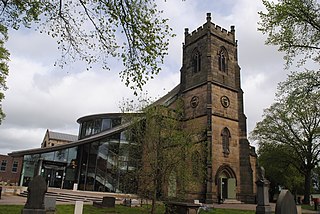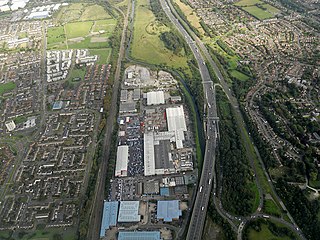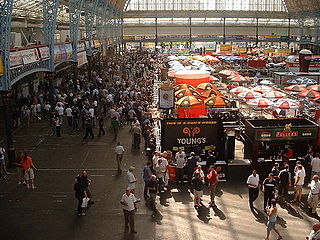
West Midlands is a metropolitan and ceremonial county in the larger West Midlands region of England. A landlocked county, it is bordered by Staffordshire to the north and west, Worcestershire to the south, and is surrounded by Warwickshire to the east. The largest settlement is the city of Birmingham.

A newsreel is a form of short documentary film, containing news stories and items of topical interest, that was prevalent between the 1910s and the mid 1970s. Typically presented in a cinema, newsreels were a source of current affairs, information, and entertainment for millions of moviegoers. Newsreels were typically exhibited preceding a feature film, but there were also dedicated newsreel theaters in many major cities in the 1930s and ’40s, and some large city cinemas also included a smaller theaterette where newsreels were screened continuously throughout the day.

Erdington is a suburb and ward of Birmingham, in the county of the West Midlands, England. Historically part of Warwickshire, it is located 5 miles (8 km) northeast of central Birmingham, bordering Sutton Coldfield. It was also a council constituency, managed by its own district committee. The former council district consisted of the ward of Erdington as well as Tyburn, Stockland Green and Kingstanding, although all of Kingstanding and most of both Tyburn and Stockland Green wards lie outside the historical boundaries of Erdington. Stockland Green was formerly part of Aston, Kingstanding part of Perry Barr, and Tyburn partially split between Aston and Hodge Hill. Erdington (ward) was part of the Sutton Coldfield constituency before 1974.
The Anti-Party Group, fully referenced in the Soviet political parlance as "the anti-Party group of Malenkov, Kaganovich, Molotov and Shepilov, who joined them" was a Stalinist group within the leadership of the Communist Party of the Soviet Union that unsuccessfully attempted to depose Nikita Khrushchev as First Secretary of the Party in June 1957. The group, given that epithet by Khrushchev, was led by former Premiers Georgy Malenkov and Vyacheslav Molotov and former First Deputy Premier Lazar Kaganovich. The group rejected both Khrushchev's liberalization of Soviet society and his denunciation of Joseph Stalin, and promoted the full restoration and preservation of Stalinism.

Castle Bromwich is a large suburban village and civil parish in the Metropolitan Borough of Solihull in the West Midlands, England. It borders the rest of the borough to the south east, Sutton Coldfield to the east and north east, Shard End to the south west, Castle Vale, Erdington and Minworth to the north and Hodge Hill to the west.

The Franco-British Exhibition was a large public fair held in London between 14 May and 31 October 1908. It was the first in the series of the White City Exhibitions. The exhibition attracted 8 million visitors and celebrated the Entente Cordiale signed in 1904 by the United Kingdom and France. The chief architect of the buildings was John Belcher.

The London XI was a football team that represented the city of London in the 1955–58 Inter-Cities Fairs Cup.

Earls Court Exhibition Centre was a major international exhibition and events venue in London, England. At its peak it is said to have generated a £2 billion turnover for the economy. It replaced exhibition and entertainment grounds, originally opened in 1887, with an art moderne structure built between 1935 and 1937 by specialist American architect C. Howard Crane. With the active support of London mayor Boris Johnson, in an attempt to create Europe's "largest regeneration scheme", its proposed heritage listing was refused after it was acquired by developers, who promptly in 2008 applied for and were granted a Certificate of Immunity from Listing by English Heritage, and its demolition was completed in 2017.

The Great British Beer Festival is an annual beer festival organised by the Campaign for Real Ale (CAMRA). It presents a selection of cask ales, and the Champion Beer of Britain awards, and is held in August of each year. GBBF's sister festival, the Great British Beer Festival Winter, is held in February each year.

Sentinel is a 16-metre-high (52 ft) sculpture by Tim Tolkien, installed upon Spitfire Island, a roundabout at the intersection of the Chester Road and the A47 Fort Parkway at the entrance to the Castle Vale estate in Birmingham, England.

The first Inter-Cities Fairs Cup took place over three seasons from 1955 to 1958. The competition began with a group stage with each team playing home and away against each other. Due to the competition rules which stated only one side from each city was allowed to compete, many cities with several football clubs picked the best players from those teams to create a city representative side. One of these, the London XI, went on to reach the final where they were beaten over two legs by the Barcelona XI.
Castle Bromwich Aerodrome was an early airfield, situated to the north of Castle Bromwich in the West Midlands of England. The site now falls within the City of Birmingham.

Castle Bromwich Assembly is a factory owned by Jaguar Land Rover. It is located on the Chester Road in Castle Vale, Birmingham, England and employs 3,200 people. The plant is situated on a 110-acre (45 ha) site, with a 60,000 square metres (650,000 sq ft) manufacturing facility. It formerly manufactured all Jaguar saloon and sports cars, prior to production at the site concluding in May 2024.

Pathé News was a producer of newsreels and documentaries from 1910 to 1970 in the United Kingdom. Its founder, Charles Pathé, was a pioneer of moving pictures in the silent era. The Pathé News archive is known today as "British Pathé". Its collection of news film and movies is fully digitised and available online.

The Empire Exhibition was an international Exhibition held at Bellahouston Park in Glasgow, Scotland, from May to December 1938.

Nikolai Alexandrovich Bulganin was the Premier of the Soviet Union from 1955 to 1958. He also served as Minister of Defense, following service in the Red Army during World War II.
Arthur Lummis Gibson was a British politician and trade unionist, who served as Lord Mayor of Birmingham.
The 1957 October Revolution Parade was a parade on Moscow's Red Square dedicated to the ruby jubilee of the Great October Socialist Revolution on 7 November 1957.

The former government of Georgy Malenkov was dissolved on February 8, 1955, and Bulganin succeeded Malenkov as premier of the Soviet Union that day. He was generally seen as a supporter of Khrushchev's reforms and destalinisation. In July 1955, he attended the Geneva Summit, with U.S. President Dwight D. Eisenhower, French Prime Minister Edgar Faure, and British Prime Minister Anthony Eden. He and Khrushchev travelled together to India, Yugoslavia and in April 1956 to Britain, where they were known in the press as "the B and K show" or "Bulge and Crush". In his memoirs, however, Khrushchev recounted that he believed that he "couldn't rely on [Bulganin] fully."














